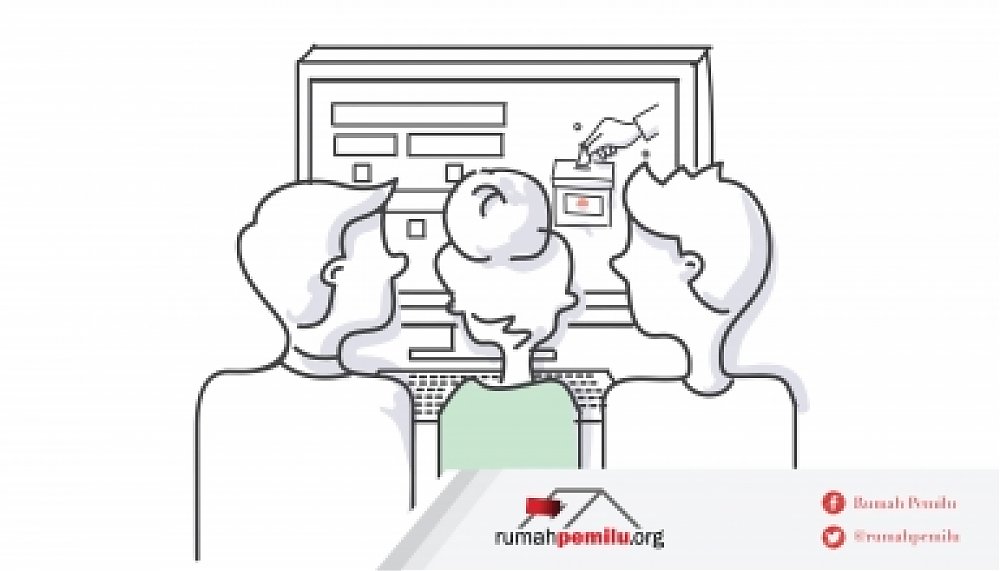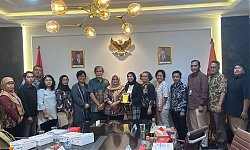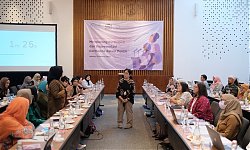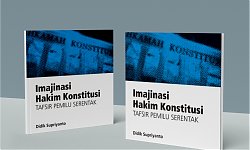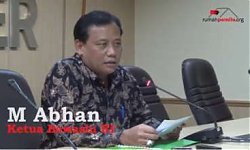Monday (7/12), the General Election Commission (KPU) of Indonesia held a Coffee Morning related to Recapitulation Information System (Sirekap) at the KPU RI office, Menteng, Central Jakarta. In the activity, KPU explained the readiness, recapitulation mechanism to be carried out, as well as scenarios of the use of sirekap in various situations related to the role of Sirekap as the publication of the results of vote counting.
Sirekap is different from Situng
Although both are sound recapitulation information systems, sirekap is different from the Counting Information System (Situng). If in Situng scanning of Form C1 Copy is done in KPU Regency / City with scanner, on Sirekap, scanning with sirekap application is done on Form C KWK results by KPPS in TPS.
"Well, for this sirekap, for transparency, he went down to the polling station. So, at the TPS level we can directly publish with Sirekap," said KPU RI member, Evi Novida Ginting.
Sirekap is utilized in the 2020 Regional Elections throughout the regional elections as a test of electronic recapitulation in its position as a tool to process recapitulation and publication of results. According to Evi, Sirekap also eased the work of KPPS by making filling out Form C1 Copies into fewer, and making elections more environmentally friendly because there is not much paper.
Sirekap readiness
In order for the recapitulation to run smoothly and Sirekap as a tool as well as electronic recapitulation trials to function properly, KPU has made several preparations, such as mapping the condition of the internet network throughout the regional elections, relocating tps to available places on the internet network, creating TPS coordinates as verification of delivery of results, as well as providing technical guidance (bimtek) to kpps whose process is still ongoing until Monday, December 7, or H-2 days of voting.
"This is all we create TPS coordinates, so that we can monitor the TPS coordinates points and can map with the help of cooperation with the Cominfo. So, we already have a map of coordinates that have a network and do not have a network," said Evi.
From the rumahpemilu.org, KPU has conducted at least six simulations and trials. From the information submitted by Evi, the last trial was conducted to KPPS.
In the range of 5 to 7 December, KPPS is installing Sirekap application whose application can be downloaded on play store, and account activation. In areas with difficult internet conditions or no network, kpps in charge are directed to move to areas with good internet access or enough to install and activate. KPU said 96 percent of KPPS officers have successfully carried out the installation and activation process.
Recapitulation mechanism
There are two sirekap bases. One, application-based sirekap. Two, web-based sirekap. Web-based sirekap is provided at the sub-district, district/city, and provincial levels.
Application-based sirekap itself is provided in two models, namely online sirekap and offline sirekap. Sirekap offline will only be used by kpps if there is no internet network or transfer to areas where there is an internet network can not be done because the mileage is too far. Every KPPS officer assigned to operate Sirekap is required to install Sirekap online and offline.
"Not all regions have strong signal availability. So, there are weak, medium, strong, even some who do not have internet. Well, to overcome these infrastructure constraints, we prepare an offline mobile sirekap," explained Evi.
Utilization of Sirekap application requires an Android-based smartphone. Therefore, at the time of kpps recruitment, KPU requested that PPS recruit at least two KPPS officers who have Android-based smartphones.
Meanwhile, the utilization of web-based sirekap requires laptops or computers in the sub-district, KPU Regency / City, and KPU Province.
Before polling day, KPPS is required to install and activate Sirekap account. For activation, NIK and kpps mobile number must have been registered by KPU Kabupaten/Kota. If your NIK and mobile number have not been registered, activation cannot be done.
In doing activation, KPPS must carefully enter the NIK and mobile phone number. If the system recognizes the NIK and mobile phone number, then the system will send an activation link. After that, KPPS will be directed to create the password of sirekapnya account.
After the process is successful, the KPPS will be asked to re-enter the name, NIK, and password. Login from Sirekap application also requires access code in the form of kpps digital signature. It is intended as a cybersecurity filter.
In general, the recapitulation mechanism will run as follows. After the vote counting is completed and the results are set forth in kwk C Result Form, KPPS officers who have successfully activated the account will open the Sirekap application. Then, KPPS photographed form C kwk results with mobile phone. If the result of the photo has been good, then the photo will automatically be converted into number data by the application. However, if the results of the photo are not yet clear, then kpps can re-photo three times.
"Repeat up to 3 times. After the results were good, then the results of the photo was converted through Sirekap. If there is a conversion that is not in accordance with the C KWK or plenary results that are still displayed in the TPS, can be edited. This process is still taking place at the TPS, witnessed by witnesses and TPS Supervisors," said Evi.
After conversion in accordance with Form C KWK results, then KPPS will commit to kpu server. In this process, witnesses of candidates and supervisors of TPS will be asked for approval to submit the results of the vote counting by the KPPS.
After submitting, the results recorded by Sirekap application will be printed out and sent to witnesses, TPS Supervisors, and PPS through barcodes containing urls or emails. The three parties will also be given a copy of the Vote Counting Result Form as a document that will be used to match the results of the vote counting at the recapitulation at the sub-district level.
"The copy was brought in for a recap at PPK to match the Web Sirekap. If there is a discrepancy of form C kwk results read with those recaped on the Web, we refer to the Recapitulation Copy Form, and will be corrected and justified. Then the results that were read earlier, printed out, read again by witnesses and Panwas, then signed to be ratified. It was scanned in the district, newly uploaded to the KPU server to be published on the Sirekap Web that will be used as a recap in the District / City and Province," explained Evi.
The process in the sub-district will again be carried out at the district / city and provincial levels for the Election of Governors. Thus, the reading of the Recapitulation Form at each level is still carried out, and matched with the copy owned by the witness and Panwas, and matched also with the data on the Web Sirekap.
Form C KWK results are specially designed
KPU informs that at the 2020 Concurrent Elections, the news of the event and the certificate of the results of the counting of votes are made together. Both are given the term Kwk C Result Form.
The form has been specially designed for three things. One, to be compatible with Web Sirekap and Sirekap applications. Two, efficiency. Three, easy photo reading by sirekap application and accuracy of reading.
"The size of the plano used in the TPS, this is the only form in the TPS for the results of the vote counting. The first page is administration related. Contains voter data, voting rights users, disabilities, use of ballots. This is the initial part of Form C kwk results which is an event news form and certificate. Unlike the previous elections, the news of the event and certificates were thinned," said Head of Technical Subsection of KPU RI, Andi Bagus Makawaru at Coffee Morning activities.
For the accuracy of form reading and verification by application, form also comes with special boxes. The boxes become the limit of reading tasks by OCR (Optical Character Recognition) technology in Sirekap application.
"In addition to limiting data, this mark also restricts all parts of the Form as a whole. On other pages, too, there are diagonal marks so that the application can identify that the photographed is the second, third, and so on," said Bagus.
Although every page of the Form has a special mark, not all pages of KWK C Result Form will be converted by the application. Only the first page contains administrative information and the fourth page contains the results of the paslon vote, the number of voters, and the number of used and damaged ballots that will be converted to data. All pages must be photographed correctly by the KPPS.
"All parts of these boundaries must be included in the camera frame at the time kpps do the photo. There will be verification if any parts are truncated. And, that first page, if there's a misreading, can be edited. However, if there is a misreading on the fourth page, it cannot be edited. But, we have provided OMR reading format to be accurate," said Bagus.
The technology used in sirekap application to convert photos into number data is combined OCR with OMR (Optical Mark Recognition).
Some scenarios of utilizing Sirekap as a publication
For areas that are experiencing internet network constraints, KPU has prepared four scenarios. This scenario was carried out as a consequence of the use of Sirekap as a publication of the results of counting and recapitulation of votes. Because, manual recapitulation (reading the Result Form and matching with a copy of the Result Form held by witnesses and Panwas) is still run with three tools that depend on the availability of electronic and network equipment, namely Web Sirekap, Excel, and Plano paper.
"When we use the Web Sirekap, but the recap process takes place manually with the reading C KWK results from tps. Because at the subdistrict level, opened one by one ballot box. Then, it is read and matched with the copy owned by the witness and Panwas at the tps," said Evi.
The first scenario, if TPS is in an area where there is no internet network, but KPPS has an Android smartphone and has installed and activated the Sirekap application.
The mechanism that will be carried out is, Form C KWK results will be photographed by kpps in tps using offline sirekap. The photos will then be saved on the phone in .zip. The .zip submitted by the KPPS to the PPS in conjunction with the submission of the ballot box.
"So, the meeting between KPPS and PPS, whether there is or not sirekap, remains because there is a process of handing over the ballot box. Well, that's when the .zip be submitted to pps," said Bagus.
After that, there are two methods that can be done by KPPS. First, if the situation permits, the KPPS will shift several kilometers to areas that have an internet network. In the area, KPPS will use the online Sirekap application to send and check converted data. The data will be automatically entered in the District Web Sirekap.
Second, if it is not possible to shift or the location of the area with the internet network is too far, then the PPS that receives the .zip file will hand over the file along with the voice box to the PPK. The .zip will be uploaded to the District Web Sirekap by PPK. This second option requires an internet connection in the subdistrict.
The second scenario, when tps and sub-districts have no internet, but KPPS has a smartphone and has installed and activated sirekap account.
The mechanism that is carried out is, KPPS does a photo of Form C KWK results, then provides .zip files to pps to be submitted to ppk, then PPK will shift to sub-districts or districts / cities that have an internet network.
"When PPK can shift, then the recapitulation place shifts to the existing place of internet. This is not easy because it has to coordinate with witnesses and sub-district committees. So, all parties involved in the plenary meeting recapitulation must be present," said Bagus.
If in the process of transferring .zip files from KPPS to PPS and from PPS to PPK something like a broken flash or PPS does not have a smart phone, then PPK will do photos, upload photos, and check the conversion results in places where there is an internet network. Photo of Form C KWK results are done first before reading Form C KWK Results. The point is, so that the data has been entered into the server and can be followed up in the recapitulation process in the sub-district.
"So, the one who did the photo is PPK. So, the role of KPPS is PPK. So, the use of mobile sirekap application is not only KPPS, but also PPK," said Bagus.
In this second mechanism, there are other alternatives if PPK can not shift to a place where there is an internet network but there are laptops or computers and electricity, namely using offline with Excel. If there are no computers or laptops and electricity in the sub-district, then the recapitulation of the results is done using Plano Form D results paper.
For the purposes of publishing the results, PPK will submit .zip files to the KPU Regency / City. The .zip will be uploaded to the Regency/City Web Sirekap.
The third scenario, when TPS, Kecamatan, and KPU Kabupaten / Kota there is no internet network.
The mechanism is, recpaitulation is done with Excel or Plano paper at the sub-district and district / city level. Then, after the recapitulation plenary meeting is completed, the KPU District / City will shift to other districts / cities that have an internet network to upload data on the results of vote counting in the TPS.
"So, this is done after the plenary is over. For example, the Arfak Mountains could shift to Manokwari. So, the slide is only KPU because the plenary meeting is over. He moved to upload the data," said Bagus.
Informed by Bagus, that technically, KPU Regency / City can not upload data to the District / City Web Sirekap. Therefore, in the conditions as described, the KPU Regency / City must create ppk users.
The fourth scenario, when KPPS is not connected to the internet and PPS does not have a smart phone.
What will be done is, the operator of KPU Kabupaten / Kota will go down to the sub-district at the time of the plenary meeting at the sub-district level. This operator will photograph, upload data to the server, and check the conversion results. The number of operators will be adjusted to the needs of the sub-district.
KPU hopes that with the provision of risk mitigation and mapping of network availability in tps in 270 regional elections, the recapitulation process will run smoothly. As of Monday (7/12), there are 149 polling stations in West Papua that will recapitulate using Plano paper. Meanwhile, 29 districts in West Papua and 43 districts in Papua will conduct recapitulation using Excel.
"We hope, before the recap at ppk level, preparations have been made. There's a timeframe between the 10th and the 14th for the recap. So, of course we hope that all can finish according to the stages that have been determined," evi concluded.

